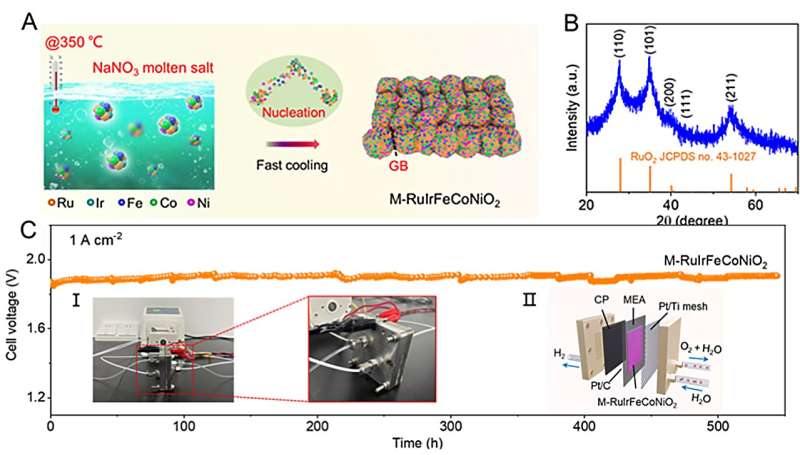This article has been reviewed according to Science X's editorial process and policies. Editors have highlighted the following attributes while ensuring the content's credibility:
fact-checked
peer-reviewed publication
trusted source
proofread
Innovative catalyst advances acidic water splitting technology

Researchers from the Shanghai Institute of Ceramics of the Chinese Academy of Sciences, together with collaborators, have made a significant breakthrough in electrocatalytic water splitting, a key technology for converting intermittent solar and wind energy into clean hydrogen fuel.
According to the study published in Science Advances, quinary high-entropy ruthenium iridium-based oxide holds promise for large-scale application in proton exchange membrane water electrolyzer (PEMWE).
In the pursuit of a hydrogen society, electrocatalytic water splitting has emerged as a potential solution. However, the acidic operating environment of the proton exchange membrane (PEM) has posed challenges for the long-term use of ruthenium oxide (RuO2). Now, the researchers led by Prof. Wang Xianying have discovered a quinary high-entropy five-membered ruthenium iridium-based oxide (M-RuIrFeCoNiO2), which has promising applications in PEMWE.
They developed a unique synthesis strategy for M-RuIrFeCoNiO2 to create abundant grain boundaries (GBs). This innovation significantly improves the catalytic activity and stability of RuO2 in acidic oxygen evolution reactions (OER), overcoming previous limitations.
The deliberate integration of foreign metal elements and GBs into the oxide catalyst played a pivotal role in improving OER activity and stability. This groundbreaking approach effectively solves the thermodynamic solubility problems associated with different metal elements.
Practical application tests showed remarkable results, as a PEMWE using the M-RuIrFeCoNiO2 catalyst maintained a high current density of 1 A cm-2 for more than 500 hours. This achievement marks a significant advancement in PEMWE technology and holds promise for the large-scale production of clean hydrogen fuel.
This study not only demonstrates a novel synthesis strategy for high entropy oxides, but also provides valuable insights into their activity and stability in the context of PEMWE, contributing to the advancement of clean energy solutions.
More information: Chun Hu et al, Misoriented high-entropy iridium ruthenium oxide for acidic water splitting, Science Advances (2023). DOI: 10.1126/sciadv.adf9144
Journal information: Science Advances
Provided by Chinese Academy of Sciences




















